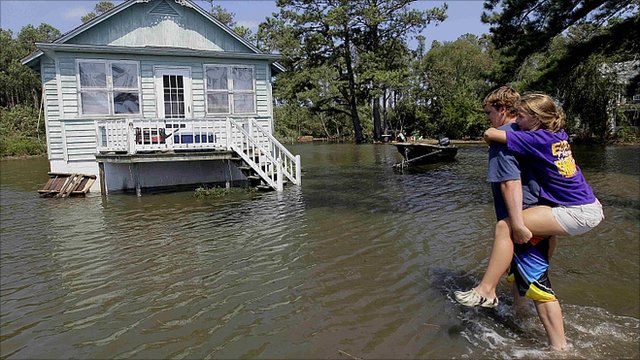 Rescue efforts are intensifying in flood-hit parts of the north-eastern US, as the death toll continues to rise two days after a fierce storm.
Rescue efforts are intensifying in flood-hit parts of the north-eastern US, as the death toll continues to rise two days after a fierce storm.
Authorities have struggled to deliver supplies to Vermont and to New York towns isolated by washed-away roads.
Tropical Storm Irene killed 40 people in the US and caused billions of dollars worth of damage.
Meanwhile, the Federal Emergency Management Agency (Fema) has warned of shortfalls in a disaster relief fund.
The agency's director Craig Fugate is due to visit Vermont on Tuesday, after warning that some projects to rebuild areas of the Midwest struck by tornados earlier in the year could be postponed.
'Long slog ahead'
At the White House on Monday, Mr Fugate warned that Fema funds are to be directed towards "immediate needs".
"We are not taking any money away from survivors," Mr Fugate said, denying that the agency was diverting funds from previous disaster survivors to fund the Irene recovery.
In Vermont, a small, mostly rural and mountainous state, more than a dozen small towns and villages remained isolated on Tuesday after roads and bridges leading in and out were washed away.
"We've got a long slog ahead," Governor Peter Shumlin told MSNBC television on Tuesday. "Irene really whacked us hard."
The state was reeling from the worst floods since 1927, and officials warned some rivers and creeks there had yet to crest.
Mr Fugate was scheduled to fly to Vermont to assess the damage and disaster relief needs, Mr Shumlin said.
Also, Homeland Security Secretary Janet Napolitano and Agriculture Secretary Tom Vilsack will visit North Carolina and Virginia to survey the storm damage.
Canada's storm
Irene passed into Canada on Sunday, after causing havoc on the US east coast from North Carolina to Vermont.
In eastern Canada, crews have begun cleaning up debris and working to restore electricity to thousands who lost power. Meanwhile, Canada's first Irene-related fatality has been recorded.
A man was swept away in Yamaska, north-east of Montreal, as two cars plunged into a chasm created when a road was washed away, Quebec police said.
In the US, a tally by the Associated Press news agency found that 40 people had been killed in 11 US states, mostly because of falling trees, ocean waves, downed power lines and raging floods.
Driving rains and flood tides damaged homes and cut power to more than three million people in New Jersey, Connecticut and New York alone.
Meanwhile, nearly 100 people remained stranded in mountain towns in New York State due to washed out roads and bridges. The storm dumped 13in of rain on the state.
New York Governor Andrew Cuomo said dozens of bridges and roadways would need to be repaired and that some of the state's rivers had yet to crest from flooding.
"You're going see more damage before it starts to get better," he told reporters on Monday.
Insurance claims could top $7bn (£4.3bn), the Consumer Federation of America estimated.
Claims for wind damage are expected to be one sixth of the total sum from Hurricane Katrina in 2005, and claims for flood damage one tenth, the CFA estimated.



